国际会计准则
国际会计准则

国际会计准则1. 引言国际会计准则(International Financial Reporting Standards,IFRS)是全球应用广泛的会计准则体系,旨在提供统一、可比的会计信息,以促进跨国公司财务报告的透明度和可理解性。
本文将探讨国际会计准则的背景、目的以及对全球财务报告的影响。
2. 国际会计准则的背景在全球化背景下,不同国家和地区都有各自的会计原则和准则,这导致跨国公司的财务报告难以比较和理解。
为了解决这个问题,国际会计准则委员会(International Accounting Standards Board,IASB)成立于2001年,致力于制定统一的国际会计准则。
3. 国际会计准则的目的国际会计准则的核心目标是提供高质量的财务报告,使投资者、债权人和其他利益相关方能够准确了解企业的财务状况和业绩。
其具体目的包括:- 提升财务报告的透明度和可比性- 减少企业在财务报告中的主观判断和自由披露- 保证财务报告的质量和真实性4. 国际会计准则对全球财务报告的影响国际会计准则的应用范围涵盖了全球范围内的上市公司、金融机构和其他组织。
其对全球财务报告的影响主要体现在以下几个方面:4.1 提供一致的会计政策选择国际会计准则的制定使得跨国公司有了一套一致的会计政策选择,降低了财务报告的主观性和歧义性,增强了国际比较的可行性和准确性。
4.2 提高财务报告的透明度和可理解性国际会计准则要求企业提供更详细和全面的财务信息,包括对业务风险和财务风险的披露。
这样一来,投资者和其他利益相关方能够更好地理解和评估企业的财务状况和业绩。
4.3 加强财务报告的质量控制国际会计准则对财务报告的准确性和真实性提出了更高的要求,要求企业建立有效的内部控制、审计和监管机制,以确保财务报告的质量和可信度。
5. 国际会计准则在全球范围的应用情况截至目前,超过120个国家和地区已经采用了国际会计准则,其中包括欧盟成员国、澳大利亚、加拿大和韩国等重要经济体。
国际会计准则(IFRS)的应用与解读
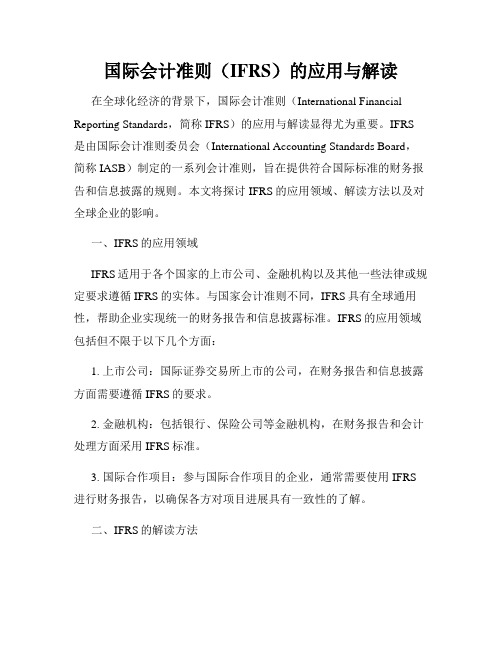
国际会计准则(IFRS)的应用与解读在全球化经济的背景下,国际会计准则(International Financial Reporting Standards,简称IFRS)的应用与解读显得尤为重要。
IFRS是由国际会计准则委员会(International Accounting Standards Board,简称IASB)制定的一系列会计准则,旨在提供符合国际标准的财务报告和信息披露的规则。
本文将探讨IFRS的应用领域、解读方法以及对全球企业的影响。
一、IFRS的应用领域IFRS适用于各个国家的上市公司、金融机构以及其他一些法律或规定要求遵循IFRS的实体。
与国家会计准则不同,IFRS具有全球通用性,帮助企业实现统一的财务报告和信息披露标准。
IFRS的应用领域包括但不限于以下几个方面:1. 上市公司:国际证券交易所上市的公司,在财务报告和信息披露方面需要遵循IFRS的要求。
2. 金融机构:包括银行、保险公司等金融机构,在财务报告和会计处理方面采用IFRS标准。
3. 国际合作项目:参与国际合作项目的企业,通常需要使用IFRS 进行财务报告,以确保各方对项目进展具有一致性的了解。
二、IFRS的解读方法IFRS的解读是确保财务报告符合国际标准的关键环节。
在解读IFRS时,应注意以下几个方面:1. 理解IFRS原则:IFRS的核心原则是公允价值、谨慎性、实质合同等,因此在解读IFRS时,应理解这些原则的含义,确保正确理解并正确应用。
2. 研究IFRS解释与指南:IFRS解释与指南提供了对具体会计问题的解释和指导,对于需要解读IFRS的企业来说,应深入研究这些解释与指南,以避免偏差和误解。
3. 利用实例和案例:在解读IFRS时,可以通过实例和案例来帮助理解和应用。
通过分析实际情况和具体案例,对IFRS进行解读和应用,既能增加理解的深度,又能提高应用的准确性。
三、IFRS对全球企业的影响IFRS的应用不仅对于遵循标准的企业而言是一种要求,也对全球企业产生了重要的影响。
国际会计准则与报表知识点总结
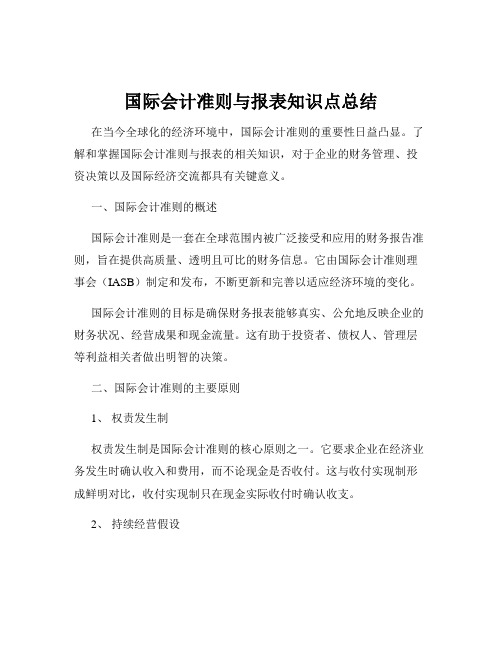
国际会计准则与报表知识点总结在当今全球化的经济环境中,国际会计准则的重要性日益凸显。
了解和掌握国际会计准则与报表的相关知识,对于企业的财务管理、投资决策以及国际经济交流都具有关键意义。
一、国际会计准则的概述国际会计准则是一套在全球范围内被广泛接受和应用的财务报告准则,旨在提供高质量、透明且可比的财务信息。
它由国际会计准则理事会(IASB)制定和发布,不断更新和完善以适应经济环境的变化。
国际会计准则的目标是确保财务报表能够真实、公允地反映企业的财务状况、经营成果和现金流量。
这有助于投资者、债权人、管理层等利益相关者做出明智的决策。
二、国际会计准则的主要原则1、权责发生制权责发生制是国际会计准则的核心原则之一。
它要求企业在经济业务发生时确认收入和费用,而不论现金是否收付。
这与收付实现制形成鲜明对比,收付实现制只在现金实际收付时确认收支。
2、持续经营假设企业在编制财务报表时通常基于持续经营假设,即假定企业将在可预见的未来持续经营下去。
如果存在证据表明企业无法持续经营,财务报表的编制基础将需要做出相应调整。
3、实质重于形式在某些情况下,交易或事项的法律形式可能与其经济实质不同。
国际会计准则要求按照经济实质进行会计处理,而不仅仅依赖于法律形式。
4、可比性和一致性财务报表应具有可比性,以便不同企业和不同时期的财务信息能够进行有意义的比较。
同时,企业在会计政策的选择和应用上应保持一致性,除非有合理的理由进行变更。
三、国际财务报表的构成国际财务报表通常包括资产负债表、利润表、现金流量表、所有者权益变动表以及相关附注。
1、资产负债表资产负债表反映了企业在特定日期的财务状况,包括资产、负债和所有者权益。
资产按照流动性从高到低排列,负债则按照到期日的远近排列。
资产分为流动资产和非流动资产。
流动资产如现金、应收账款、存货等,通常在一年内能够变现或被耗用。
非流动资产如固定资产、无形资产、长期投资等,具有较长的使用期限。
负债分为流动负债和非流动负债。
国际会计准则ias

国际会计准则ias国际会计准则(IAS)是全球范围内被广泛采纳的会计准则体系,旨在规范企业的财务报告和财务信息披露,以提高国际间财务信息的可比性和透明度。
本文将深入研究国际会计准则IAS,探讨其在全球范围内的应用情况、影响因素以及未来发展趋势。
第一章:国际会计准则IAS的概述本章将介绍国际会计准则IAS的发展历程、目标和主要内容。
首先,我们将回顾IAS的起源和发展历程,探讨其在全球范围内逐渐被采纳和应用的原因。
然后,我们将详细介绍IAS体系中包含的主要标准以及其对企业财务报告和信息披露所起到的作用。
第二章:国际会计准则IAS在全球范围内的应用情况本章将分析国际会计准则IAS在不同地区、不同类型企业中的应用情况。
我们将比较不同地区对于IAS采纳程度以及对于标准具体内容实施程度之间存在差异,并分析背后的原因。
此外,我们还将探讨IAS 在跨国公司和上市公司中的应用情况,以及IAS在发展中国家中的推广和应用挑战。
第三章:国际会计准则IAS的影响因素本章将探讨影响国际会计准则IAS应用和发展的因素。
我们将分析领导法规、金融市场、企业需求以及会计专业人员等方面对于IAS应用的影响。
此外,我们还将研究跨国公司和上市公司对于IAS采纳与实施的动机和挑战。
第四章:国际会计准则IAS与企业财务报告质量本章将研究国际会计准则IAS对企业财务报告质量的影响。
我们将分析采用IAS后企业财务报告中信息披露程度、信息可比性以及透明度等方面是否有所提高,并探讨其对投资者决策、债权人信任以及金融稳定性等方面所产生的影响。
第五章:未来发展趋势与挑战本章将展望未来国际会计准则IAS的发展趋势与面临挑战。
我们将分析全球范围内对于会计准则的统一需求以及与国际会计准则IAS的关系。
此外,我们还将探讨新兴领域和技术对于IAS的应用和发展所带来的挑战,如数字经济、云计算以及人工智能等。
结论本文通过对国际会计准则IAS的深入研究,全面探讨了其在全球范围内的应用情况、影响因素以及未来发展趋势。
ifrs国际会计准则
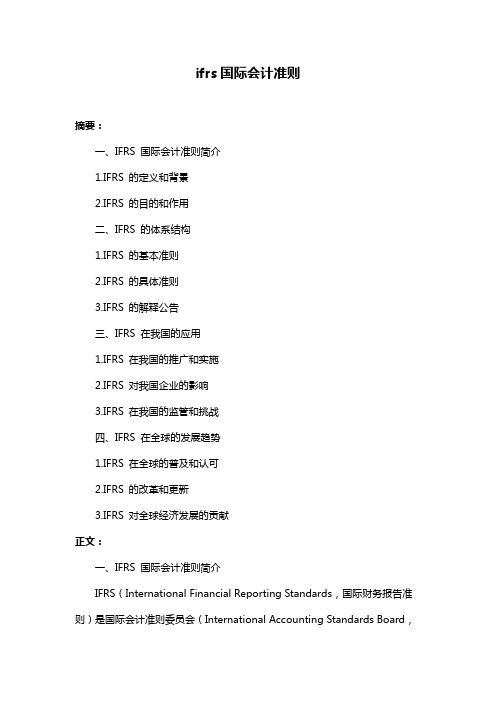
ifrs国际会计准则摘要:一、IFRS 国际会计准则简介1.IFRS 的定义和背景2.IFRS 的目的和作用二、IFRS 的体系结构1.IFRS 的基本准则2.IFRS 的具体准则3.IFRS 的解释公告三、IFRS 在我国的应用1.IFRS 在我国的推广和实施2.IFRS 对我国企业的影响3.IFRS 在我国的监管和挑战四、IFRS 在全球的发展趋势1.IFRS 在全球的普及和认可2.IFRS 的改革和更新3.IFRS 对全球经济发展的贡献正文:一、IFRS 国际会计准则简介IFRS(International Financial Reporting Standards,国际财务报告准则)是国际会计准则委员会(International Accounting Standards Board,IASB)制定的一套全球统一的会计准则。
自20 世纪70 年代起,随着全球经济一体化的发展,各国企业跨境投资和融资活动日益频繁,国际间会计信息的可比性和透明度成为迫切需要解决的问题。
IFRS 便是在这样的背景下应运而生,旨在为全球提供一个统一、高质量的会计准则体系,以促进国际资本市场的有效运行。
IFRS 的主要目的是确保财务报告在各种企业和行业的跨国交易中具有可靠、可比和透明的信息,从而为投资者、债权人、管理层等利益相关者提供有用的决策信息。
IFRS 不仅在全球范围内得到广泛应用,而且已成为许多国家国内会计准则的参考标准,对全球经济发展产生了深远影响。
二、IFRS 的体系结构IFRS 体系包括三个层次:基本准则、具体准则和解释公告。
1.基本准则:是整个IFRS 体系的基石,规定了财务报告的基本原则、假设和概念。
目前,IASB 已经发布了16 项基本准则,涵盖了财务报告的编制、披露和列报等方面。
2.具体准则:是在基本准则的基础上,针对具体业务和行业制定的详细规定。
目前,IASB 已经发布了超过200 项具体准则,涉及资产、负债、收入、费用、所得税、养老金等多个领域。
国际会计准则和中国会计准则的比较

国际会计准则和中国会计准则的比较会计准则是为了规范和统一财务报告的编制和披露而制定的一系列规则和原则。
国际会计准则及国际财务报告准则(IFRS)是由国际会计准则委员会(IASB)制定的,被广泛应用于世界各国。
中国会计准则(CAS)则是中国国家财政部发布的适用于中国境内企业的会计规范。
本文将对国际会计准则和中国会计准则进行比较,从财务报告的内容、原则、应用领域和执行要求等方面展开分析。
一、财务报告的内容国际会计准则要求财务报告包括资产、负债、所有者权益、收入和费用五大要素。
资产和负债按照预期利益流入或流出的次序排列,所有者权益根据实际权益的来源归类,收入和费用按照经济性质分开报告。
中国会计准则的财务报告内容相对更加详细。
除了资产、负债、所有者权益、收入和费用外,还包括其他综合收益、现金流量表、留存收益、利润分配等内容。
这些信息可以更全面地反映企业的财务状况和经营情况。
二、原则的差异国际会计准则强调“公允价值”原则,即根据市场价格或者理论模型确定资产和负债的价值。
而中国会计准则更加注重“成本”原则,即按照实际成本进行计量。
这导致在一些具体问题上两者存在差异。
例如,在投资物业的会计处理上,国际会计准则要求将房地产按公允价值计量,而中国会计准则要求将房地产按成本计量。
这就导致同一份财务报告中,不同会计准则下的资产价值可能存在差异。
另一个例子是在金融工具的会计处理上,国际会计准则要求将金融工具按公允价值计量,而中国会计准则则允许根据合同规定或者成本计量进行分类处理。
这也导致在金融工具的计量和披露上两种准则存在一定的差异。
三、应用领域的差异国际会计准则被广泛应用于跨国公司和上市公司,以及在国际交易中需要使用国际财务报告准则的企业。
它的应用范围广泛,能够满足全球资本市场的需求。
中国会计准则主要适用于中国境内的企业,包括上市公司和非上市公司。
中国会计准则与中国公司法律、税务法规相衔接,更加符合中国国情和法律法规的要求。
会计的国际会计准则和国际财务报告准则

会计的国际会计准则和国际财务报告准则国际会计准则(International Accounting Standards,IAS)以及国际财务报告准则(International Financial Reporting Standards,IFRS)是全球范围内规范会计准则与财务报告的重要标准。
这些准则为企业提供了指导,确保其财务报告的准确性、一致性和可比性。
本文将对国际会计准则和国际财务报告准则进行详细介绍,并探讨其在全球范围内的应用和意义。
一、国际会计准则(IAS)国际会计准则是国际会计准则委员会(International Accounting Standards Board,IASB)制定的一系列会计准则。
这些准则旨在为全球企业提供一个统一的会计规则框架,以确保财务报告的准确性和可比性。
国际会计准则的制定过程严格遵循透明、公正、可复制和可公众接受的原则。
每个准则都经过广泛的民意征询和专家评审,以确保其代表了全球会计界的共识和最佳实践。
国际会计准则主要关注以下几个方面:1. 会计政策选择和会计估计的准确性和一致性。
2. 财务报表项目的定义、计量和披露。
3. 财务报表的格式和布局。
4. 各类交易、资产和负债的计量和确认。
国际会计准则的持续演进和修订使得其具备了更强的适应性和灵活性。
随着全球经济的快速发展,新的会计问题也不断涌现,因此国际会计准则需要不断地进行修订和更新,以满足新的业务需求和挑战。
二、国际财务报告准则(IFRS)国际财务报告准则是国际财务报告准则基金会(International Financial Reporting Standards Foundation,IFRS Foundation)制定的财务报告准则。
与国际会计准则不同,国际财务报告准则更加注重财务报告的内容和披露要求。
国际财务报告准则致力于提升财务报告的质量和透明度,以满足全球投资者的需求。
它规范了财务报告的核心要素、报告周期、信息披露和报表附注等方面,确保报告的准确性和一致性。
国际会计准则
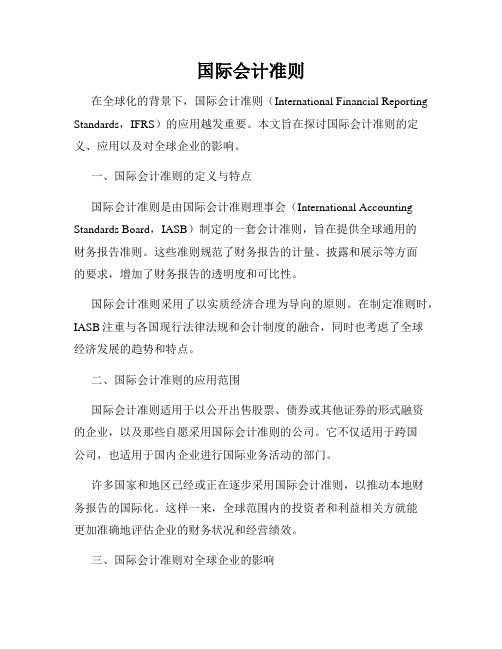
国际会计准则在全球化的背景下,国际会计准则(International Financial Reporting Standards,IFRS)的应用越发重要。
本文旨在探讨国际会计准则的定义、应用以及对全球企业的影响。
一、国际会计准则的定义与特点国际会计准则是由国际会计准则理事会(International Accounting Standards Board,IASB)制定的一套会计准则,旨在提供全球通用的财务报告准则。
这些准则规范了财务报告的计量、披露和展示等方面的要求,增加了财务报告的透明度和可比性。
国际会计准则采用了以实质经济合理为导向的原则。
在制定准则时,IASB注重与各国现行法律法规和会计制度的融合,同时也考虑了全球经济发展的趋势和特点。
二、国际会计准则的应用范围国际会计准则适用于以公开出售股票、债券或其他证券的形式融资的企业,以及那些自愿采用国际会计准则的公司。
它不仅适用于跨国公司,也适用于国内企业进行国际业务活动的部门。
许多国家和地区已经或正在逐步采用国际会计准则,以推动本地财务报告的国际化。
这样一来,全球范围内的投资者和利益相关方就能更加准确地评估企业的财务状况和经营绩效。
三、国际会计准则对全球企业的影响1. 提高财务报告的可比性国际会计准则的应用使得企业之间的财务报告更具可比性。
通过统一的计量、披露和展示要求,投资者和利益相关方能够更加准确地比较不同企业的财务状况和经营绩效,降低了信息不对称的风险。
2. 加强全球市场的透明度国际会计准则的应用提高了财务报告的透明度,使全球市场更加透明和规范。
这有助于吸引国际投资者,促进国际资本流动,提升全球市场竞争力。
3. 降低企业财务成本国际会计准则的应用减少了企业因向不同国家提交财务报告而需要进行的调整工作。
统一的准则和处理方式简化了财务报告的制作流程,降低了制度和人力成本。
4. 促进国际审核和监管合作国际会计准则的应用促进了国际间的审核和监管合作。
国际会计准则

国际会计准则国际会计准则(International Financial Reporting Standards,缩写为IFRS)是国际财务报告准则委员会(International Accounting Standards Board,简称IASB)制定的一系列会计准则,旨在统一全球各国的财务会计报告准则,提高财务信息的可比性和透明度。
本文将介绍IFRS的背景、目标、原则以及对全球财务报告准则的影响等内容。
IFRS的背景可追溯到20世纪70年代初,当时国际上存在着许多不同的会计准则,各国之间的会计报告无法进行比较,国际商业活动存在着信息不对称的问题。
为了解决这一问题,国际会计准则委员会于2001年成立。
IASB代表了全球会计专业的权威机构,其成员由来自不同国家和地区的专业人士组成,他们的任务是制定适用于全球金融市场的一致、透明的会计准则。
IFRS的目标是提供财务报告的一致性和可比性,以便投资者、债权人和其他利益相关者能够更好地理解和评估企业的财务状况和经营绩效。
IFRS要求企业按照公允价值计量、销售发生时点和经济实质等原则编制财务报表,以确保报告信息的准确性、可靠性和相关性。
IFRS包括一系列具体的会计准则,主要涵盖财务报表编制、资产负债表、利润表、现金流量表、准则解释等方面。
所有上市公司和一些大型私营企业都被要求按照IFRS编制和公开财务报告。
此外,IFRS还适用于其他一些领域,例如银行和保险业。
IFRS的实施对全球财务报告准则产生了深远影响。
首先,IFRS的统一规定使得企业的财务报表更加可比,跨国公司能够更容易地进行业绩比较和分析。
其次,IFRS的公允价值计量和合同会计模式等原则的引入,使财务报告更加准确地反映企业的经济实质。
再次,IFRS的实施促进了国际投资和跨境融资的发展,提高了全球金融市场的透明度和稳定性。
总之,国际会计准则作为全球金融报告准则的统一标准,增加了全球金融市场的透明度和比较性,对于提高企业财务信息的可靠性和相关性发挥了重要作用。
国际会计准则
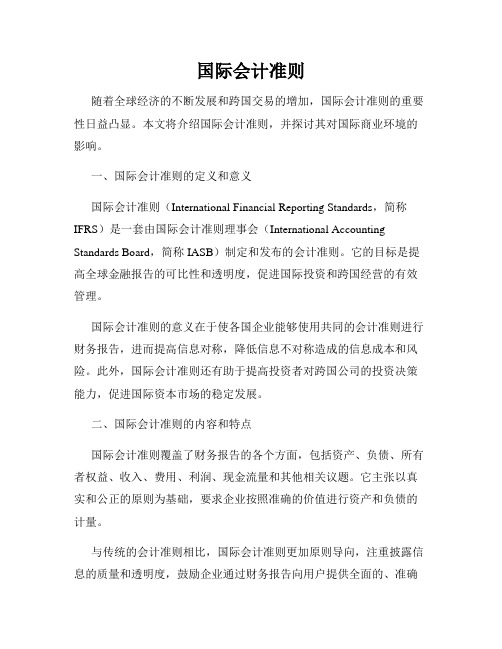
国际会计准则随着全球经济的不断发展和跨国交易的增加,国际会计准则的重要性日益凸显。
本文将介绍国际会计准则,并探讨其对国际商业环境的影响。
一、国际会计准则的定义和意义国际会计准则(International Financial Reporting Standards,简称IFRS)是一套由国际会计准则理事会(International Accounting Standards Board,简称IASB)制定和发布的会计准则。
它的目标是提高全球金融报告的可比性和透明度,促进国际投资和跨国经营的有效管理。
国际会计准则的意义在于使各国企业能够使用共同的会计准则进行财务报告,进而提高信息对称,降低信息不对称造成的信息成本和风险。
此外,国际会计准则还有助于提高投资者对跨国公司的投资决策能力,促进国际资本市场的稳定发展。
二、国际会计准则的内容和特点国际会计准则覆盖了财务报告的各个方面,包括资产、负债、所有者权益、收入、费用、利润、现金流量和其他相关议题。
它主张以真实和公正的原则为基础,要求企业按照准确的价值进行资产和负债的计量。
与传统的会计准则相比,国际会计准则更加原则导向,注重披露信息的质量和透明度,鼓励企业通过财务报告向用户提供全面的、准确的信息。
此外,国际会计准则还对各种交易,如金融衍生工具、租赁合同等制定了具体的会计处理要求,以提高会计信息的可比性和准确性。
三、国际会计准则对国际商业环境的影响国际会计准则的推广和采用对国际商业环境产生了深远的影响。
首先,它促进了全球资本市场的一体化,提高了投资者对国际公司的投资决策能力。
通过使用统一的会计准则,投资者可以更好地比较不同国家公司的财务状况和经营绩效,减少了信息不对称带来的投资风险。
其次,国际会计准则的采用还为跨国公司的财务报告提供了统一的框架。
跨国公司可以根据国际会计准则的规定编制财务报告,简化了报告程序,降低了成本,并提高了报告的可比性和准确性。
此外,国际会计准则的推广还促进了国际交流与合作的便利化。
中国会计准则与国际会计准则差异
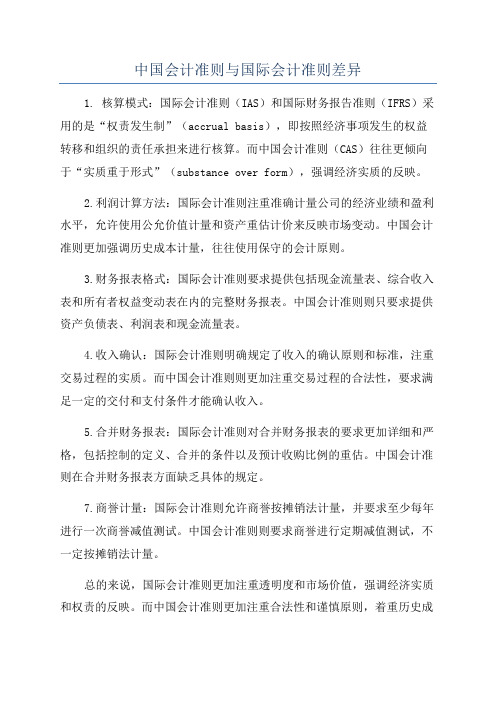
中国会计准则与国际会计准则差异
1. 核算模式:国际会计准则(IAS)和国际财务报告准则(IFRS)采用的是“权责发生制”(accrual basis),即按照经济事项发生的权益转移和组织的责任承担来进行核算。
而中国会计准则(CAS)往往更倾向于“实质重于形式”(substance over form),强调经济实质的反映。
2.利润计算方法:国际会计准则注重准确计量公司的经济业绩和盈利水平,允许使用公允价值计量和资产重估计价来反映市场变动。
中国会计准则更加强调历史成本计量,往往使用保守的会计原则。
3.财务报表格式:国际会计准则要求提供包括现金流量表、综合收入表和所有者权益变动表在内的完整财务报表。
中国会计准则则只要求提供资产负债表、利润表和现金流量表。
4.收入确认:国际会计准则明确规定了收入的确认原则和标准,注重交易过程的实质。
而中国会计准则则更加注重交易过程的合法性,要求满足一定的交付和支付条件才能确认收入。
5.合并财务报表:国际会计准则对合并财务报表的要求更加详细和严格,包括控制的定义、合并的条件以及预计收购比例的重估。
中国会计准则在合并财务报表方面缺乏具体的规定。
7.商誉计量:国际会计准则允许商誉按摊销法计量,并要求至少每年进行一次商誉减值测试。
中国会计准则则要求商誉进行定期减值测试,不一定按摊销法计量。
总的来说,国际会计准则更加注重透明度和市场价值,强调经济实质和权责的反映。
而中国会计准则更加注重合法性和谨慎原则,着重历史成
本和保守的计量方法。
尽管存在一些差异,但中国会计准则在不断迎合国际趋势,逐渐与国际会计准则接轨。
国际会计准则(IAS)应用与解读了解国际会计准则在实际应用中的要求和解读
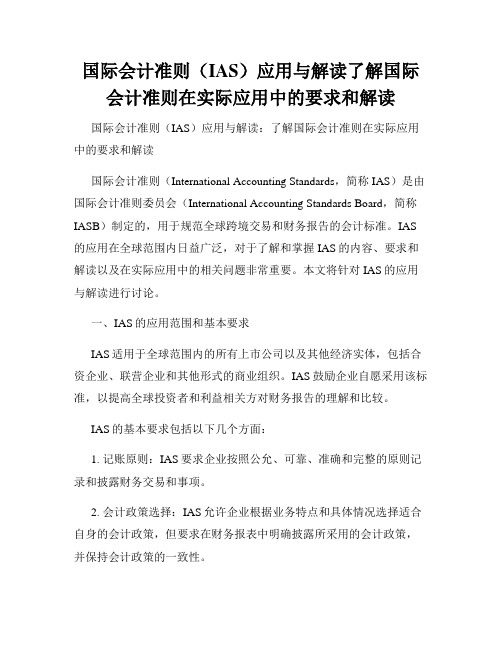
国际会计准则(IAS)应用与解读了解国际会计准则在实际应用中的要求和解读国际会计准则(IAS)应用与解读:了解国际会计准则在实际应用中的要求和解读国际会计准则(International Accounting Standards,简称IAS)是由国际会计准则委员会(International Accounting Standards Board,简称IASB)制定的,用于规范全球跨境交易和财务报告的会计标准。
IAS 的应用在全球范围内日益广泛,对于了解和掌握IAS的内容、要求和解读以及在实际应用中的相关问题非常重要。
本文将针对IAS的应用与解读进行讨论。
一、IAS的应用范围和基本要求IAS适用于全球范围内的所有上市公司以及其他经济实体,包括合资企业、联营企业和其他形式的商业组织。
IAS鼓励企业自愿采用该标准,以提高全球投资者和利益相关方对财务报告的理解和比较。
IAS的基本要求包括以下几个方面:1. 记账原则:IAS要求企业按照公允、可靠、准确和完整的原则记录和披露财务交易和事项。
2. 会计政策选择:IAS允许企业根据业务特点和具体情况选择适合自身的会计政策,但要求在财务报表中明确披露所采用的会计政策,并保持会计政策的一致性。
3. 资产、负债和所有者权益确认和计量:IAS规定了各种类型资产、负债和所有者权益的确认和计量准则,旨在实现财务报表的可比性和一致性。
4. 财务报告披露要求:IAS要求企业向利益相关方提供真实、可理解和及时的财务信息,包括重大会计政策、财务报表附注、管理层讨论与分析等。
二、IAS在实际应用中的解读与问题IAS在实际应用中可能遇到一些解读问题和相关争议,这需要会计人员和相关利益相关方进行深入的理解和研究。
1. 核心概念的解读:IAS中涉及的核心概念如公允价值、资产减值、收入确认等,需要在实际应用中进行具体解读和操作,以确保会计处理符合标准的要求。
2. 专业判断和估计:IAS要求会计人员在确定财务报表项目时进行专业判断和估计,这可能涉及到一些主观性和不确定性,需要权衡各种因素和利益,尽量确保信息的真实和可靠。
国际会计准则(IFRS)与国内会计准则之比较
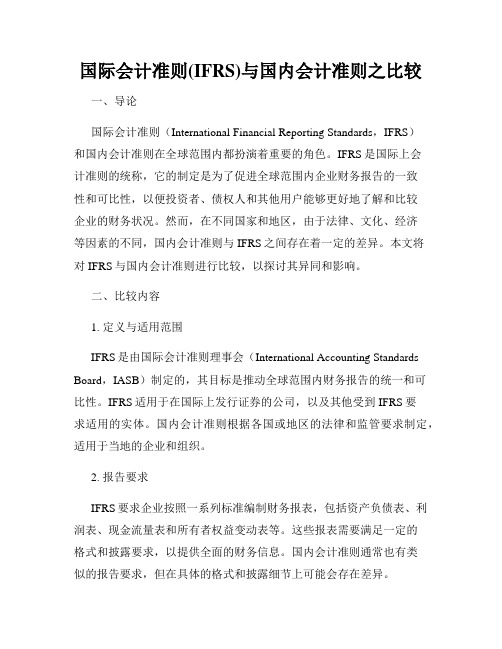
国际会计准则(IFRS)与国内会计准则之比较一、导论国际会计准则(International Financial Reporting Standards,IFRS)和国内会计准则在全球范围内都扮演着重要的角色。
IFRS是国际上会计准则的统称,它的制定是为了促进全球范围内企业财务报告的一致性和可比性,以便投资者、债权人和其他用户能够更好地了解和比较企业的财务状况。
然而,在不同国家和地区,由于法律、文化、经济等因素的不同,国内会计准则与IFRS之间存在着一定的差异。
本文将对IFRS与国内会计准则进行比较,以探讨其异同和影响。
二、比较内容1. 定义与适用范围IFRS是由国际会计准则理事会(International Accounting Standards Board,IASB)制定的,其目标是推动全球范围内财务报告的统一和可比性。
IFRS适用于在国际上发行证券的公司,以及其他受到IFRS要求适用的实体。
国内会计准则根据各国或地区的法律和监管要求制定,适用于当地的企业和组织。
2. 报告要求IFRS要求企业按照一系列标准编制财务报表,包括资产负债表、利润表、现金流量表和所有者权益变动表等。
这些报表需要满足一定的格式和披露要求,以提供全面的财务信息。
国内会计准则通常也有类似的报告要求,但在具体的格式和披露细节上可能会存在差异。
3. 计量基础IFRS强调公允价值计量,即根据市场价格或合理估计来确定资产和负债的价值。
这一计量基础反映了市场价格的变动和公司价值的变化。
而国内会计准则通常采用历史成本计量,即以购买或生产资产时的实际成本作为其价值基础。
这两种计量基础在反映企业财务状况和经营业绩方面存在一定的差异。
4. 披露要求IFRS对于报表中的披露要求相对较为详细和严格,以确保财务信息的充分披露。
它要求企业提供与会计政策、重要会计估计和假设、关联方交易等相关的披露。
国内会计准则可能在某些方面要求更多的披露,但在其他方面可能较为灵活。
国际会计准则(IFRS)与国内会计准则之比较

国际会计准则(IFRS)与国内会计准则之比较国际会计准则与国内会计准则之比较简介:国际会计准则(International Financial Reporting Standards,简称IFRS)是一套由国际会计准则理事会(International Accounting Standards Board,简称IASB)制定的统一的会计准则框架。
国内会计准则则根据各国内部立法机构或会计专业机构的制定,以满足国内会计和金融报告的需求。
本文将重点比较IFRS和国内会计准则在以下几个方面的异同:1. 核心原则与基本特征:IFRS强调公允价值计量、持续经营、会计主体和会计周期等核心原则,并强调全面反映经济业务的基本特征。
国内会计准则则更加注重历史成本计量和谨慎性原则,关注企业偿付能力和稳定性。
2. 财务报表的内容和格式:IFRS要求财务报表包括资产负债表、利润表、现金流量表和权益变动表等,以及主要会计政策和附注信息。
国内会计准则根据国情和监管需求对财务报表的内容和格式进行调整。
3. 会计处理和会计政策:IFRS对于会计处理和会计政策给予较大的灵活性,允许企业根据实际情况选择合适的会计政策。
国内会计准则则相对更为规范,少有选择权,强制执行标准的会计处理和会计政策。
4. 公司合并与业务组合:IFRS对于公司合并与业务组合的会计处理更加详细和具体,要求按照市场价值进行资产和负债的确认和计量。
国内会计准则则对公司合并和业务组合的会计处理相对较为简化,侧重于合并方案的编制和披露。
5. 资本化与费用化的界定:IFRS对于资本化与费用化的界定较为灵活,要求企业根据可确认的未来经济利益和相关成本的可计量性做出判断。
国内会计准则则相对更为严格,要求企业按照成本的发生顺序和可确认的未来经济利益进行界定。
6. 特殊行业的会计处理要求:IFRS针对特殊行业的会计处理要求较少,更注重原则性和灵活性,对于金融、石油、航空等行业提供了一些具体的指导。
中国会计准则,国际会计准则
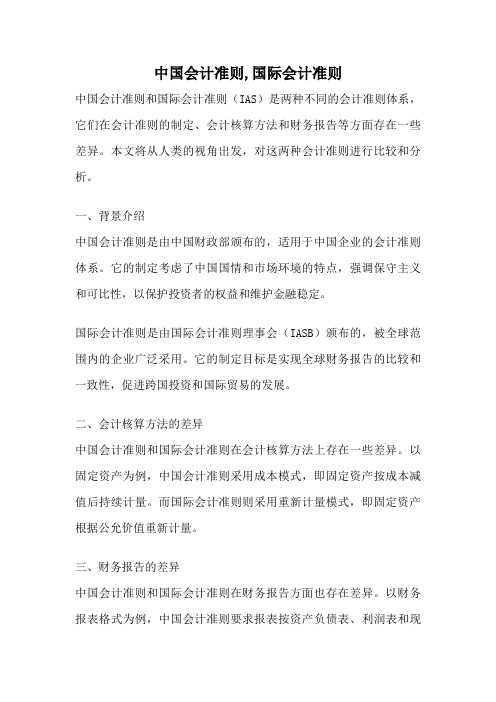
中国会计准则,国际会计准则中国会计准则和国际会计准则(IAS)是两种不同的会计准则体系,它们在会计准则的制定、会计核算方法和财务报告等方面存在一些差异。
本文将从人类的视角出发,对这两种会计准则进行比较和分析。
一、背景介绍中国会计准则是由中国财政部颁布的,适用于中国企业的会计准则体系。
它的制定考虑了中国国情和市场环境的特点,强调保守主义和可比性,以保护投资者的权益和维护金融稳定。
国际会计准则是由国际会计准则理事会(IASB)颁布的,被全球范围内的企业广泛采用。
它的制定目标是实现全球财务报告的比较和一致性,促进跨国投资和国际贸易的发展。
二、会计核算方法的差异中国会计准则和国际会计准则在会计核算方法上存在一些差异。
以固定资产为例,中国会计准则采用成本模式,即固定资产按成本减值后持续计量。
而国际会计准则则采用重新计量模式,即固定资产根据公允价值重新计量。
三、财务报告的差异中国会计准则和国际会计准则在财务报告方面也存在差异。
以财务报表格式为例,中国会计准则要求报表按资产负债表、利润表和现金流量表的顺序编制。
而国际会计准则则没有明确规定报表的编制顺序,但强调财务报表应当提供充分的信息。
四、对投资者的影响中国会计准则和国际会计准则对投资者的影响也存在差异。
中国会计准则注重保护投资者的权益,强调保守主义和可比性,以提高投资者的信任度。
而国际会计准则注重财务报告的比较和一致性,以提供全球范围内的投资机会。
五、未来发展趋势中国会计准则和国际会计准则在未来的发展趋势上也存在一些差异。
中国会计准则正在逐步向国际会计准则靠拢,以提高中国企业的国际竞争力。
而国际会计准则在不断修订和完善,以适应全球经济的发展和变化。
中国会计准则和国际会计准则在制定背景、会计核算方法、财务报告、对投资者的影响以及未来发展趋势等方面存在差异。
了解和掌握这些差异,对于企业和投资者来说都具有重要的意义。
因此,在进行国际贸易和投资时,需要根据具体情况选择合适的会计准则,并遵守相应的规定和要求。
ifrs国际会计准则

ifrs国际会计准则摘要:一、IFRS国际会计准则的背景和意义1.IFRS的发展历程2.IFRS在全球范围内的应用和影响二、IFRS的核心理念和原则1.公允价值计量2.资产减值损失3.职工福利计划三、IFRS在我国的应用和实施1.我国对IFRS的引入和接受过程2.IFRS在我国会计准则体系中的地位3.我国企业实施IFRS的挑战与机遇四、IFRS对我国企业和经济的影响1.IFRS对我国企业财务报告的影响2.IFRS对我国资本市场的完善和发展作用3.IFRS对我国企业国际竞争力的提升正文:IFRS国际会计准则,全称国际财务报告准则(International Financial Reporting Standards),是由国际会计准则委员会(International Accounting Standards Board,简称IASB)制定并发布的一系列会计准则。
自20世纪70年代起,IFRS经历了从欧洲国家到全球范围内的推广和应用,现已成为国际上广泛接受的一种会计准则体系。
IFRS的核心理念是公允价值计量、资产减值损失和职工福利计划等原则。
公允价值计量原则要求企业对其资产、负债和权益进行公允价值计量,以更准确地反映企业的财务状况。
资产减值损失原则要求企业对资产减值损失进行及时确认和计量,以防止企业通过低估资产减值损失来虚增利润。
职工福利计划原则要求企业对职工福利计划进行充分披露,以使投资者更好地了解企业的福利支出和负债状况。
我国在2007年开始引入IFRS,并在2008年发布了《企业会计准则》,实现了我国会计准则与国际财务报告准则的实质性趋同。
IFRS在我国会计准则体系中的地位日益重要,对于完善我国资本市场、提高企业国际竞争力具有重大意义。
IFRS对我国企业和经济的影响深远。
首先,IFRS要求企业进行更严格的财务报告,有助于提高企业财务报告的透明度,为投资者提供更为准确的信息,从而降低资本市场的信息不对称。
说国际会计准则(IFRS)与国内会计准则之比较
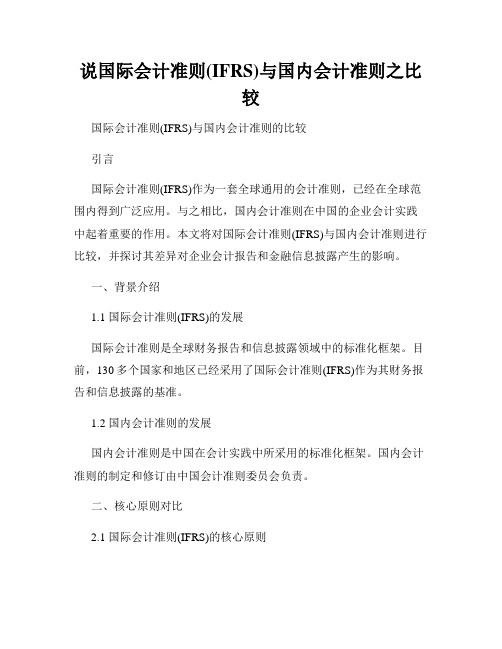
说国际会计准则(IFRS)与国内会计准则之比较国际会计准则(IFRS)与国内会计准则的比较引言国际会计准则(IFRS)作为一套全球通用的会计准则,已经在全球范围内得到广泛应用。
与之相比,国内会计准则在中国的企业会计实践中起着重要的作用。
本文将对国际会计准则(IFRS)与国内会计准则进行比较,并探讨其差异对企业会计报告和金融信息披露产生的影响。
一、背景介绍1.1 国际会计准则(IFRS)的发展国际会计准则是全球财务报告和信息披露领域中的标准化框架。
目前,130多个国家和地区已经采用了国际会计准则(IFRS)作为其财务报告和信息披露的基准。
1.2 国内会计准则的发展国内会计准则是中国在会计实践中所采用的标准化框架。
国内会计准则的制定和修订由中国会计准则委员会负责。
二、核心原则对比2.1 国际会计准则(IFRS)的核心原则国际会计准则(IFRS)以公允价值计量为核心原则,强调资产和负债在财务报表中的准确反映,以及信息的可比性和透明度。
2.2 国内会计准则的核心原则国内会计准则注重谨慎事项计量,强调谨慎性和稳定性,在财务报表中凸显企业的盈利能力和现金流量。
三、财务报表要求对比3.1 国际会计准则(IFRS)的财务报表要求根据国际会计准则(IFRS),财务报表应包括资产负债表、利润表、现金流量表和所有者权益变动表。
3.2 国内会计准则的财务报表要求国内会计准则要求财务报表包括资产负债表、利润表、现金流量表和所有者权益变动表,同时还要编制附注和管理层讨论与分析报告。
四、重要差异分析4.1 概念框架的差异国际会计准则(IFRS)的概念框架强调公允价值、可比性和透明度,而国内会计准则更注重企业的稳定性和谨慎性。
4.2 关键会计政策的不同国际会计准则(IFRS)允许管理层根据实际情况选择会计政策,而国内会计准则更加注重会计政策的统一性和稳定性。
4.3 资产和负债的计量差异国际会计准则(IFRS)强调公允价值计量,而国内会计准则更注重成本或成本减值计量。
42个国际会计准则

42个国际会计准则42个国际会计准则是国际会计准则委员会(International Accounting Standards Board,IASB)发布的一系列规范,旨在为全球范围内的企业提供统一的会计准则。
这些准则涵盖了各个方面的会计处理和披露要求,对于确保财务报告的准确性和可比性起到了重要的作用。
接下来将介绍其中一些重要的准则。
IAS 1《财务报表展示》规定了财务报表的编制和展示要求。
该准则规定了财务报表的基本要素,如资产、负债、所有者权益、收入和费用,并规定了报表的格式和披露要求,以确保财务报表的真实和公正。
IAS 16《固定资产》规定了固定资产的会计处理和披露要求。
该准则明确了固定资产的初始计量、后续计量和资产减值测试,并规定了折旧和摊销的方法,以确保固定资产在财务报表中得到正确的反映。
第三,IAS 36《资产减值》规定了资产减值测试的要求。
该准则要求企业在每个会计期末对资产进行减值测试,以确定其是否有发生减值的迹象。
如果有减值迹象,企业需要根据减值测试的结果进行相应的减值准备。
第四,IAS 38《无形资产》规定了无形资产的会计处理和披露要求。
该准则明确了无形资产的初始计量和后续计量,以及无形资产的摊销和资产减值测试的方法,确保无形资产在财务报表中得到正确的反映。
第五,IAS 37《拨备、资产负债和担保》规定了拨备、资产负债和担保的会计处理和披露要求。
该准则要求企业根据相关法规和会计准则的规定,对潜在负债进行计量和披露,并对可能的拨备进行估计。
第六,IAS 12《所得税》规定了所得税的会计处理和披露要求。
该准则明确了企业在财务报表中计量和披露所得税负债和所得税资产的方法,以确保所得税在财务报表中得到正确的反映。
除了上述几个准则外,还有许多其他重要的国际会计准则,如IAS 2《存货》、IAS 7《现金流量表》、IAS 17《租赁》、IAS 18《收入》等。
每个准则都有其独特的会计处理和披露要求,旨在确保财务报表的准确性和可比性。
国际会计准则是由国际会计准则理事会(IASB)制定的全球会计准则目的是提高财务报告的可比性和透明度

国际会计准则是由国际会计准则理事会(IASB)制定的全球会计准则目的是提高财务报告的可比性和透明度国际会计准则:提高财务报告的可比性和透明度简介:国际会计准则是由国际会计准则理事会(IASB)制定的全球会计准则,其主要目的是提高财务报告的可比性和透明度。
本文将探讨国际会计准则的背景和重要性,并分析其对全球企业和投资者的影响。
第一部分:国际会计准则的背景自20世纪70年代起,全球化进程加快,跨国公司的数量和规模不断增长。
然而,不同国家和地区采用的会计准则千差万别,导致财务报告的可比性较低,投资者难以比较和理解不同公司之间的财务状况。
为解决这一问题,国际会计准则理事会应运而生。
第二部分:国际会计准则的制定机构国际会计准则理事会(IASB)是负责制定和发布国际会计准则的全球性机构。
该理事会由多个国家和地区的专业会计组织组成,致力于制定具有广泛适用性和权威性的会计准则。
IASB的成员具有丰富的国际会计经验和专业知识,确保会计准则的制定具有全球视野和专业性。
第三部分:国际会计准则的重要性1. 提高财务报告的可比性:国际会计准则的制定使得不同公司之间的财务报表更具可比性。
投资者可以更好地理解和评估不同公司的财务状况,从而做出更明智的投资决策。
2. 增强财务报告的透明度:国际会计准则要求公司以透明的方式披露财务信息,防范潜在的欺诈行为。
这有助于提高市场的透明度,促进投资者的信心和市场稳定。
3. 促进全球经济发展:统一的会计准则有助于跨国公司进行跨境经营,降低交易成本,推动国际投资和贸易的便利化。
4. 强化监管和合规性:国际会计准则为监管机构提供了一个较为统一和规范的基准,更好地实施监管和监察,并加强对企业财务状况和风险的监控。
第四部分:国际会计准则对全球企业和投资者的影响1. 企业层面:全球性的会计准则使得跨国公司在各个国家间的财务报告更加便捷和可操作。
这有助于提高企业的管理效率和决策能力,促进业务扩张和合作。
国际会计准则(IFRS)与国内会计准则(CAS)对比
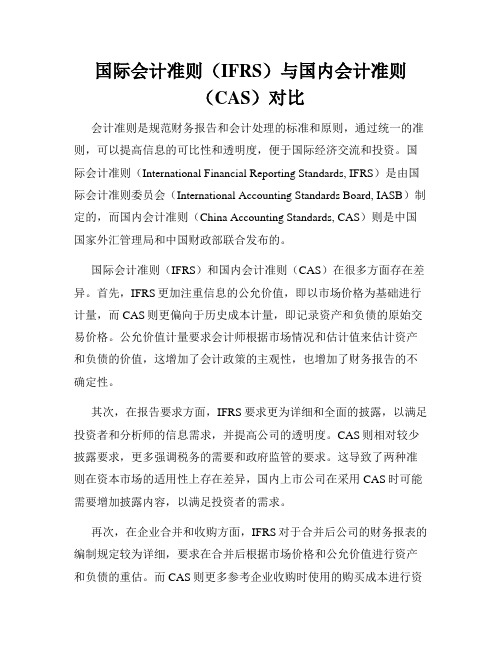
国际会计准则(IFRS)与国内会计准则(CAS)对比会计准则是规范财务报告和会计处理的标准和原则,通过统一的准则,可以提高信息的可比性和透明度,便于国际经济交流和投资。
国际会计准则(International Financial Reporting Standards, IFRS)是由国际会计准则委员会(International Accounting Standards Board, IASB)制定的,而国内会计准则(China Accounting Standards, CAS)则是中国国家外汇管理局和中国财政部联合发布的。
国际会计准则(IFRS)和国内会计准则(CAS)在很多方面存在差异。
首先,IFRS更加注重信息的公允价值,即以市场价格为基础进行计量,而CAS则更偏向于历史成本计量,即记录资产和负债的原始交易价格。
公允价值计量要求会计师根据市场情况和估计值来估计资产和负债的价值,这增加了会计政策的主观性,也增加了财务报告的不确定性。
其次,在报告要求方面,IFRS要求更为详细和全面的披露,以满足投资者和分析师的信息需求,并提高公司的透明度。
CAS则相对较少披露要求,更多强调税务的需要和政府监管的要求。
这导致了两种准则在资本市场的适用性上存在差异,国内上市公司在采用CAS时可能需要增加披露内容,以满足投资者的需求。
再次,在企业合并和收购方面,IFRS对于合并后公司的财务报表的编制规定较为详细,要求在合并后根据市场价格和公允价值进行资产和负债的重估。
而CAS则更多参考企业收购时使用的购买成本进行资产账面价值的确认。
这导致了在跨国企业合并与收购时,IFRS的准则更受到国际投资者和交易对手的认可。
此外,IFRS还具有全球接受程度高的特点,是国际上公认的会计准则,受到全球投资者和跨国公司的广泛应用。
而CAS则更加符合中国国情和法律的要求,在国内应用广泛。
两者的差异主要源于文化、经济制度和监管环境等方面的差异。
- 1、下载文档前请自行甄别文档内容的完整性,平台不提供额外的编辑、内容补充、找答案等附加服务。
- 2、"仅部分预览"的文档,不可在线预览部分如存在完整性等问题,可反馈申请退款(可完整预览的文档不适用该条件!)。
- 3、如文档侵犯您的权益,请联系客服反馈,我们会尽快为您处理(人工客服工作时间:9:00-18:30)。
International Accounting StandardsIAS 23 Borrowing Costs (revised 1993)This revised International Accounting Standard supersedes IAS 23, Capitalisation of Borrowing Costs, approved by the Board in March 1984. The revised Standard became effective for financial statements covering periods beginning on or after 1 January 1995.One SIC Interpretation relates to IAS 23:SIC-2: Consistency - Capitalisation of Borrowing Costs.The standards, which have been set in bold italic type, should be read in the context of the background material and implementation guidance in this Standard, and in the context of the Preface to International Accounting Standards. International Accounting Standards are not intended to apply to immaterial items (see paragraph 12 of the Preface).ObjectiveThe objective of this Standard is to prescribe the accounting treatment for borrowing costs. This Standard generally requires the immediate expensing of borrowing costs. However, the Standard permits, as an allowed alternative treatment, the capitalisation of borrowing costs that are directly attributable to the acquisition, construction or production of a qualifying asset.Scope1. This Standard should be applied in accounting for borrowing costs.2. This Standard supersedes IAS 23, Capitalisation of Borrowing Costs, approved in 1983.3. This Standard does not deal with the actual or imputed cost of equity, including preferred capital not classified as a liability.Definitions4. The following terms are used in this Standard with the meanings specified:Borrowing costs are interest and other costs incurred by an enterprise in connection with the borrowing of funds.A qualifying asset is an asset that necessarily takes a substantial period of time to get ready for its intended use or sale.5. Borrowing costs may include:(a) interest on bank overdrafts and short-term and long-term borrowings;(b) amortisation of discounts or premiums relating to borrowings;(c) amortisation of ancillary costs incurred in connection with the arrangement of borrowings;(d) finance charges in respect of finance leases recognised in accordance with IAS 17, Leases; and(e) exchange differences arising from foreign currency borrowings to the extent that they are regarded as an adjustment to interest costs.6. Examples of qualifying assets are inventories that require a substantial period of time to bring them to a saleable condition, manufacturing plants, power generation facilities and investment properties. Other investments, and those inventories that are routinely manufactured or otherwise produced in large quantities on a repetitive basis over a short period of time, are not qualifying assets. Assets that are ready for their intended use or sale when acquired also are not qualifying assets.Borrowing Costs - Benchmark TreatmentRecognition7. Borrowing costs should be recognised as an expense in the period in which they are incurred.8. Under the benchmark treatment borrowing costs are recognised as an expense in the period in which they are incurred regardless of how the borrowings are applied.Disclosure9. The financial statements should disclose the accounting policy adopted for borrowing costs. Borrowing Costs - Allowed Alternative TreatmentRecognition10. Borrowing costs should be recognised as an expense in the period in which they are incurred, except to the extent that they are capitalised in accordance with paragraph 11.11. Borrowing costs that are directly attributable to the acquisition, construction or production of a qualifying asset should be capitalised as part of the cost of that asset. The amount of borrowing costs eligible for capitalisation should be determined in accordance with this Standard.[1]12. Under the allowed alternative treatment, borrowing costs that are directly attributable to the acquisition, construction or production of an asset are included in the cost of that asset. Such borrowing costs are capitalised as part of the cost of the asset when it is probable that they will result in future economic benefits to the enterprise and the costs can be measured reliably. Other borrowing costs are recognised as an expense in the period in which they are incurred.Borrowing Costs Eligible for Capitalisation13. The borrowing costs that are directly attributable to the acquisition, construction or production ofa qualifying asset are those borrowing costs that would have been avoided if the expenditure on the qualifying asset had not been made. When an enterprise borrows funds specifically for the purpose of obtaining a particular qualifying asset, the borrowing costs that directly relate to that qualifying asset can be readily identified.14. It may be difficult to identify a direct relationship between particular borrowings and a qualifying asset and to determine the borrowings that could otherwise have been avoided. Such a difficultyoccurs, for example, when the financing activity of an enterprise is co-ordinated centrally. Difficulties also arise when a group uses a range of debt instruments to borrow funds at varying rates of interest, and lends those funds on various bases to other enterprises in the group. Other complications arise through the use of loans denominated in or linked to foreign currencies, when the group operates in highly inflationary economies, and from fluctuations in exchange rates. As a result, the determination of the amount of borrowing costs that are directly attributable to the acquisition ofa qualifying asset is difficult and the exercise of judgement is required.15. To the extent that funds are borrowed specifically for the purpose of obtaining a qualifying asset, the amount of borrowing costs eligible for capitalisation on that asset should be determined as the actual borrowing costs incurred on that borrowing during the period less any investment income on the temporary investment of those borrowings.16. The financing arrangements for a qualifying asset may result in an enterprise obtaining borrowed funds and incurring associated borrowing costs before some or all of the funds are used for expenditures on the qualifying asset. In such circumstances, the funds are often temporarily invested pending their expenditure on the qualifying asset. In determining the amount of borrowing costs eligible for capitalisation during a period, any investment income earned on such funds is deducted from the borrowing costs incurred.17. To the extent that funds are borrowed generally and used for the purpose of obtaining a qualifying asset, the amount of borrowing costs eligible for capitalisation should be determined by applying a capitalisation rate to the expenditures on that asset. The capitalisation rate should be the weighted average of the borrowing costs applicable to the borrowings of the enterprise that are outstanding during the period, other than borrowings made specifically for the purpose of obtaining a qualifying asset. The amount of borrowing costs capitalised during a period should not exceed the amount of borrowing costs incurred during that period.18. In some circumstances, it is appropriate to include all borrowings of the parent and its subsidiaries when computing a weighted average of the borrowing costs; in other circumstances, it is appropriate for each subsidiary to use a weighted average of the borrowing costs applicable to its own borrowings.Excess of the Carrying Amount of the Qualifying Asset over Recoverable Amount19. When the carrying amount or the expected ultimate cost of the qualifying asset exceeds its recoverable amount or net realisable value, the carrying amount is written down or written off in accordance with the requirements of other International Accounting Standards. In certain circumstances, the amount of the write-down or write-off is written back in accordance with those other International Accounting Standards.Commencement of Capitalisation20. The capitalisation of borrowing costs as part of the cost of a qualifying asset should commence when:(a) expenditures for the asset are being incurred;(b) borrowing costs are being incurred; and(c) activities that are necessary to prepare the asset for its intended use or sale are in progress.21. Expenditures on a qualifying asset include only those expenditures that have resulted in payments of cash, transfers of other assets or the assumption of interest-bearing liabilities.Expenditures are reduced by any progress payments received and grants received in connection with the asset (see IAS 20, Accounting for Government Grants and Disclosure of Government Assistance). The average carrying amount of the asset during a period, including borrowing costs previously capitalised, is normally a reasonable approximation of the expenditures to which the capitalisation rate is applied in that period.22. The activities necessary to prepare the asset for its intended use or sale encompass more than the physical construction of the asset. They include technical and administrative work prior to the commencement of physical construction, such as the activities associated with obtaining permits prior to the commencement of the physical construction. However, such activities exclude the holding of an asset when no production or development that changes the asset's condition is taking place. For example, borrowing costs incurred while land is under development are capitalised during the period in which activities related to the development are being undertaken. However, borrowing costs incurred while land acquired for building purposes is held without any associated development activity do not qualify for capitalisation.Suspension of Capitalisation23. Capitalisation of borrowing costs should be suspended during extended periods in which active development is interrupted.24. Borrowing costs may be incurred during an extended period in which the activities necessary to prepare an asset for its intended use or sale are interrupted. Such costs are costs of holding partially completed assets and do not qualify for capitalisation. However, capitalisation of borrowing costs is not normally suspended during a period when substantial technical and administrative work is being carried out. Capitalisation of borrowing costs is also not suspended when a temporary delay is a necessary part of the process of getting an asset ready for its intended use or sale. For example, capitalisation continues during the extended period needed for inventories to mature or the extended period during which high water levels delay construction of a bridge, if such high water levels are common during the construction period in the geographic region involved.Cessation of Capitalisation25. Capitalisation of borrowing costs should cease when substantially all the activities necessary to prepare the qualifying asset for its intended use or sale are complete.26. An asset is normally ready for its intended use or sale when the physical construction of the asset is complete even though routine administrative work might still continue. If minor modifications, such as the decoration of a property to the purchaser's or user's specification, are all that are outstanding, this indicates that substantially all the activities are complete.27. When the construction of a qualifying asset is completed in parts and each part is capable of being used while construction continues on other parts, capitalisation of borrowing costs should cease when substantially all the activities necessary to prepare that part for its intended use or sale are completed.28. A business park comprising several buildings, each of which can be used individually is an example of a qualifying asset for which each part is capable of being usable while construction continues on other parts. An example of a qualifying asset that needs to be complete before any part can be used is an industrial plant involving several processes which are carried out in sequence at different parts of the plant within the same site, such as a steel mill.Disclosure29. The financial statements should disclose:(a) the accounting policy adopted for borrowing costs;(b) the amount of borrowing costs capitalised during the period; and(c) the capitalisation rate used to determine the amount of borrowing costs eligible for capitalisation. Transitional Provisions30. When the adoption of this Standard constitutes a change in accounting policy, an enterprise is encouraged to adjust its financial statements in accordance with IAS 8, Net Profit or Loss for the Period, Fundamental Errors and Changes in Accounting Policies. Alternatively, enterprises following the allowed alternative treatment should capitalise only those borrowing costs incurred after the effective date of the Standard which meet the criteria for capitalisation.Effective Date31. This International Accounting Standard becomes operative for financial statements covering periods beginning on or after 1 January 1995.[1]See also SIC - 2, Consistency - Capitalisation of Borrowing Costs.。
